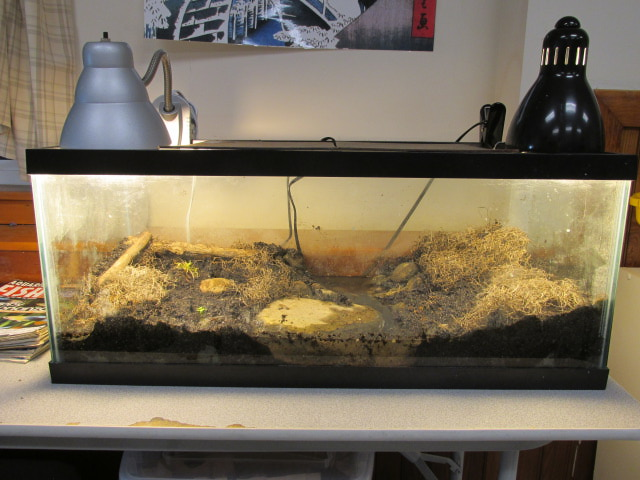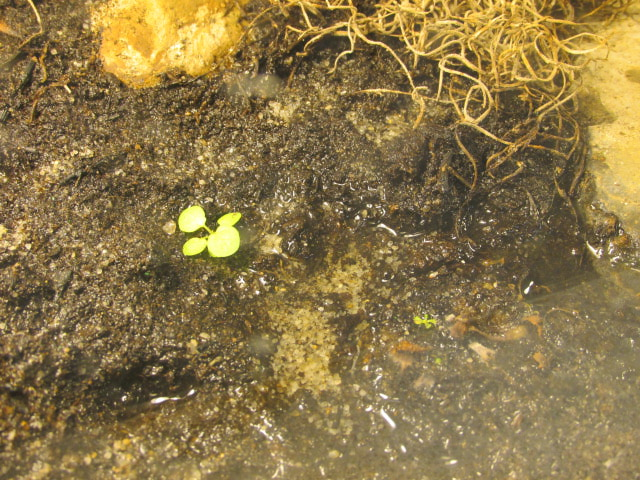Question Classroom Tank
Classroom Tank
 Close-up
Close-up
QUESTION: Hello, I am a sixth-grade teacher in Northern Maine. I have brought a few carnivorous plants into my classroom over the last year, but none have worked out well. My room gets as cold as 54 degrees F over weekends and longer breaks, and the north-facing windows (and along the walls) get below freezing many nights in the winter. Also, the forced-air heat makes the room *extremely* dry all winter, even though I run a small humidifier during the day.
I am currently trying a terrarium (a 20 gallon "long" fish tank) with a 23W CFL light on each end and about 2/3 of the top covered. There is a layer of rocks in the bottom, a mix of sand/peat/soil heaped up a bit on each side, I keep standing distilled water in the middle of the tank to try and keep some humidity in the air. Today I just added a 50 W submersible heater to the water to try and keep the tank warm this winter (pre-set at 78 degrees F; can't change it). The lights and heater are on a timer to run about 14 hours a day. I'm hoping the residual heat from the day will linger enough to keep it warm overnight.
Left-over from previous attempts are one dying Cape Sundew (brown, curling leaf tips) and two "volunteer" sprouts: a 1" sprout that may be a Floating sundew, and a miniscule sprout that might be a Spoonleaf.
I would love expert advice on how to keep a few sundews (or any other carnivorous plant) alive in my inhospitable classroom. The students are fascinated by them, and we learn about them in our science curriculum.
Thanks! Ali
ANSWER: Hello Ali,
From what you described, most of the setup sounds adequate for a majority of tropical sundews. Cape Sundews in particular are quite tolerant and easy to grow (they are actually almost impossible to kill so long as their environment provides the basics).
There are a couple of concerns:
You indicated that you have a mixture of sand, peat, and soil as a medium. What type of peat and what kind of soil? Sphagnum peat is the correct type of moss, but make sure it is not of the bagged variety from fertilizer companies. They add fertilizer to their moss fairly consistently. The proper sphagnum moss would be the dry bales of plain moss with absolutely no additives. Fertilizers in the soil will weaken and kill most carnivorous plants. In addition, if you use any other type of soil, as you indicated, make sure it is not typical garden soil or any kind of fertilizer enriched mix. Just plain sand and granulated sphagnum moss are all they will need for proper rooting material. They acquire fertilizer from trapping and digesting insects since their roots are generally unable to make use of fertilizers in the soil (many carnivorous species actually suffer root rot/burn and die rather quickly in fertilized soils).
Humidity is not a major concern. The tropical sundews you indicated are very capable of adapting to low humidity over time if they are provided easy transitions to that lower humidity level over several weeks. The main concern is to maintain high levels of light so that the plants can produce their glue drops. Look for reddening in the tentacles and leaves of many species of sundews as well as copious dew production to determine lighting needs. Add light intensity as needed to keep the sundews "dewing" properly.
While terrariums are not the best way to grow carnivorous plants, they can work so long as you provide enough drainage and air flow to reduce infectious bacteria and fungal blooms in the tank.
You might want to try clipping the Cape Sundew off at the ground level and letting the roots regenerate a new scape. That often refreshes the plant so long as the roots are healthy. In the process, you will likely acquire several new plantlets from the roots generating several new growth points. When I repot my plants, I just break off several root sections, sometimes intentionally, and plant them around the parent plants. They invariably produce multitudes of plantlets.
The "floating sundew" may not be a sundew at all. The picture you provided of the volunteer plants looks like there is one very small sundew like sprout, and one larger, plant that does not appear to possess tentacles or sundew-like growth patterns. A closer picture might provide a better idea of whether it is or is not a sundew.
---------- FOLLOW-UP ----------
QUESTION: I very much appreciate your great advice!
Actually, now that you mention it, I don't think there is any soil in there. It has been a while, but I was following a recipe I found online, and peat + sand sounds really familiar. I know the peat is okay, because I had to special-order it to avoid fertilizer. It's not an easy item to find in a small town!
The larger volunteer plant has tiny projections on the leaves, but nothing dewy. It seems to be surviving despite the distilled water and poor soil, so maybe it will live long enough to be identified when it is grown. The smaller volunteer plant is a perfect mini-sundew, complete with dew drops, and the students love it.
As far as drainage is concerned, is the standing water a problem? Would you recommend taking the cover off to increase airflow, or would that make the tank too cold and dry in the winter? My students would love a more "open" tank, as they have to peek through the sides right now.
In your follow-up message, you mentioned cutting back the Cape sundew to promote regeneration - I'll give it a try! I also moved the lights back, further away from the plants, to help with the browning leaves.
Are there any other "nearly impossible to kill" sundews you would recommend for this (less than perfect) setup? I have to shop online, and I'd like to get at least one normal-sized, healthy plant in the tank before it gets too cold to ship safely.
Thanks so much for all your help!
Ali
AnswerYou can try D. adelae (Australian lance leaf sundew) This sundew is actually a biennial that cannot be grown from seed (the U.S. sold ones are clones with no genetic variability) but they are extraordinary at reproducing from root cuttings. A single two year plant can be kept going indefinitely as the parent is cannibalized as root cuttings every year or two. A great way to study asexual reproduction in plants through cuttings.
D. alicia
D. spathulata
And the several varieties of D. capensis (African Cape Sundew) They have an all white, typical with red coloration in adequate light, and narrow leaf.
All are tropical/sub-tropical so will grow year round.
The cape sundew is actually considered a sub-tropical as it has been noted as capable of dormancy in near freezing weather even though it is primarily a tropical in seasonal growth pattern.
Having the majority of the tank open is fine. I grow all mine open pot in typical plastic pots indoors. I have a section of my room set up with several 40 watt twin tube shop lights and large plastic storage trays for water under the pots. This keeps the humidity up to about 50% and keeps them warm enough with central air and low humidity. I'm not sure if you could devote a 4 foot area of a classroom corner to that kind of setup though.
Standing water is not a huge issue with most bog plants, but bacterial buildup can be. Just make sure that you can clean the tank out periodically somehow by draining some of the water and replacing it with fresh water and annually changing out the soil to freshen it (sphagnum moss produces a lot of iodine, so is actually a bit of a bacterial inhibitor, which is why bogs are great for producing mummies).
You may want to add a bit more soil to build up the tank depth. That will allow for greater root growth. Even some of the smallest sundews boast 4-6 inches of root length.







